Gastronomy and Culinary Tourism: Exploring the Link with Cultural Tourism
VerifiedAdded on 2022/11/25
|14
|4202
|208
AI Summary
This essay discusses the concept of gastronomy and its focus on gourmet cuisine. It explores culinary tourism as a form of tourism where food exploration is the central purpose. The essay delves into the link between culinary tourism and cultural tourism, highlighting how food can be a way to understand and experience a destination's culture. It also emphasizes the importance of culinary tourism in completing the overall tourism experience, expanding local culture at a global level, creating fusions, and sharing useful knowledge. Additionally, the essay discusses the holistic benefits of culinary tourism, including its contribution to the development of the local economy and its impact on the branding and positioning of destinations.
Contribute Materials
Your contribution can guide someone’s learning journey. Share your
documents today.
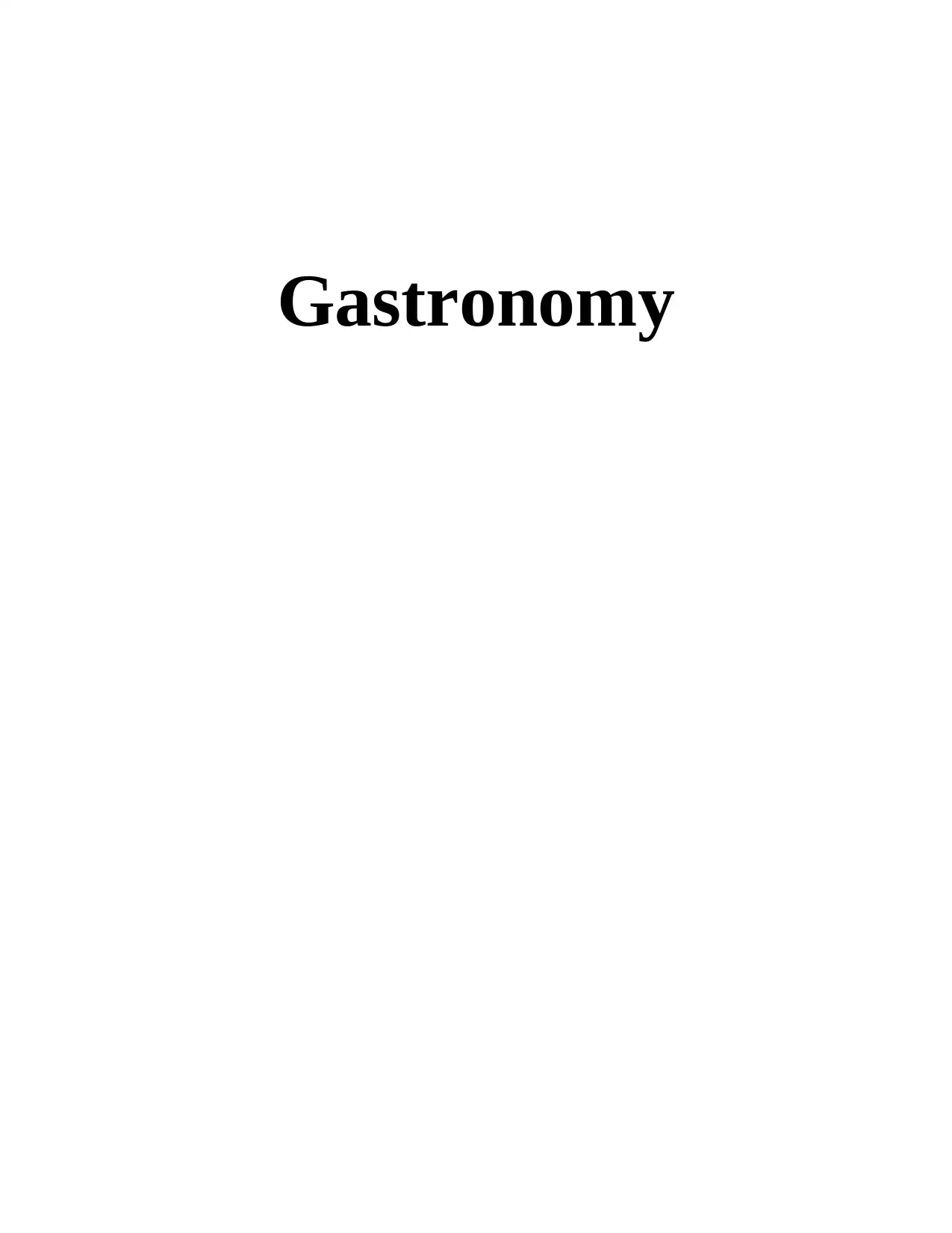
Gastronomy
Secure Best Marks with AI Grader
Need help grading? Try our AI Grader for instant feedback on your assignments.
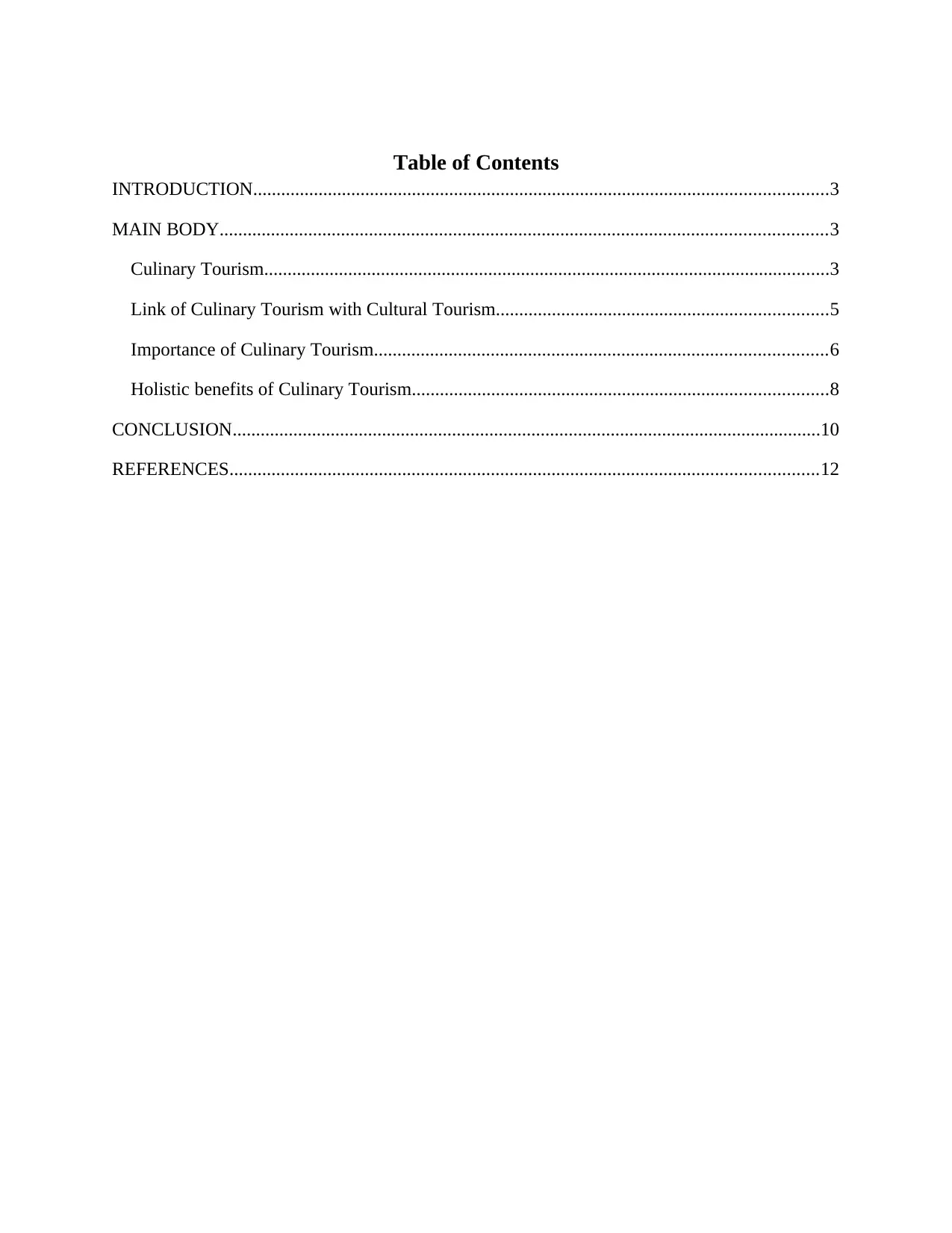
Table of Contents
INTRODUCTION...........................................................................................................................3
MAIN BODY..................................................................................................................................3
Culinary Tourism.........................................................................................................................3
Link of Culinary Tourism with Cultural Tourism.......................................................................5
Importance of Culinary Tourism.................................................................................................6
Holistic benefits of Culinary Tourism.........................................................................................8
CONCLUSION..............................................................................................................................10
REFERENCES..............................................................................................................................12
INTRODUCTION...........................................................................................................................3
MAIN BODY..................................................................................................................................3
Culinary Tourism.........................................................................................................................3
Link of Culinary Tourism with Cultural Tourism.......................................................................5
Importance of Culinary Tourism.................................................................................................6
Holistic benefits of Culinary Tourism.........................................................................................8
CONCLUSION..............................................................................................................................10
REFERENCES..............................................................................................................................12
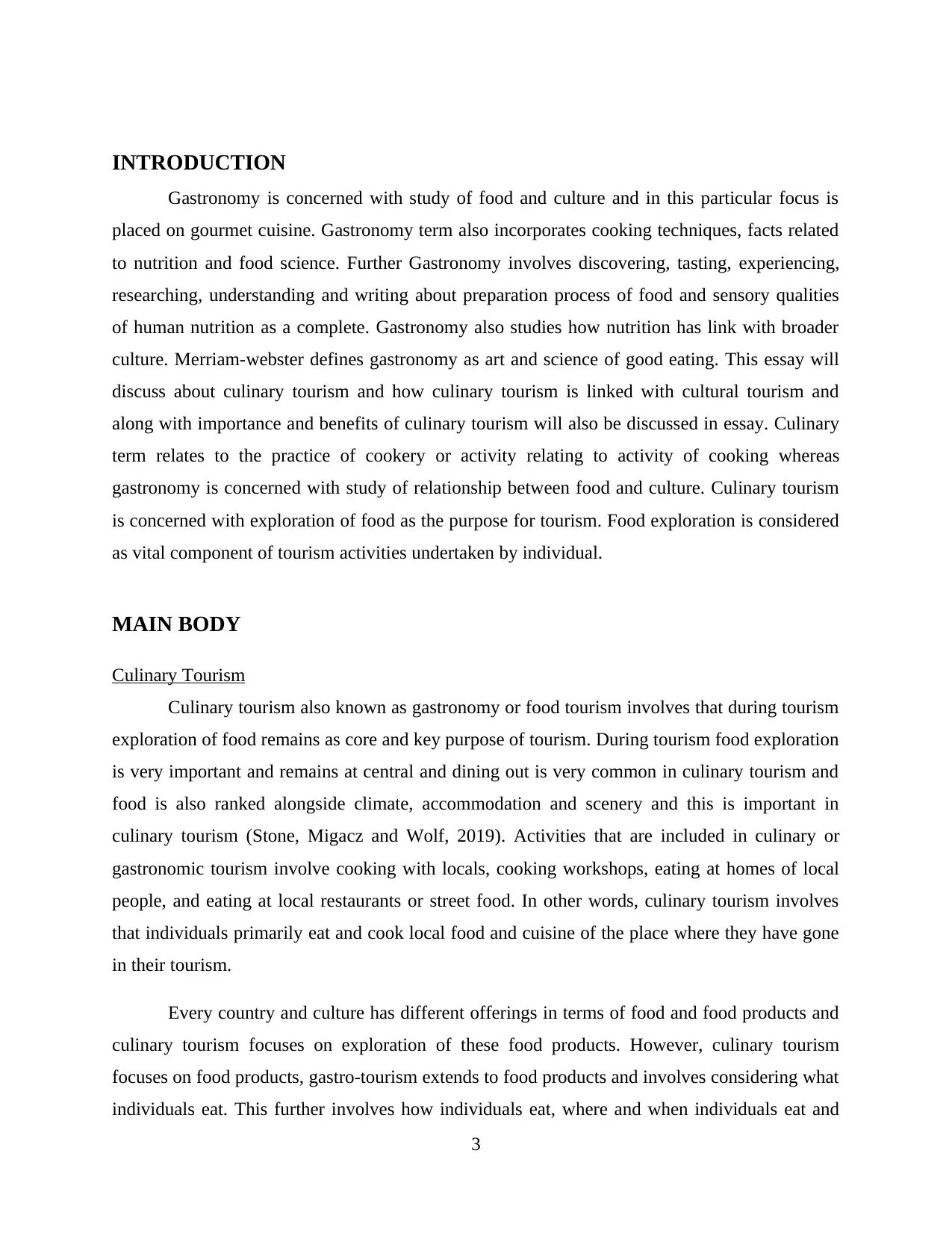
INTRODUCTION
Gastronomy is concerned with study of food and culture and in this particular focus is
placed on gourmet cuisine. Gastronomy term also incorporates cooking techniques, facts related
to nutrition and food science. Further Gastronomy involves discovering, tasting, experiencing,
researching, understanding and writing about preparation process of food and sensory qualities
of human nutrition as a complete. Gastronomy also studies how nutrition has link with broader
culture. Merriam-webster defines gastronomy as art and science of good eating. This essay will
discuss about culinary tourism and how culinary tourism is linked with cultural tourism and
along with importance and benefits of culinary tourism will also be discussed in essay. Culinary
term relates to the practice of cookery or activity relating to activity of cooking whereas
gastronomy is concerned with study of relationship between food and culture. Culinary tourism
is concerned with exploration of food as the purpose for tourism. Food exploration is considered
as vital component of tourism activities undertaken by individual.
MAIN BODY
Culinary Tourism
Culinary tourism also known as gastronomy or food tourism involves that during tourism
exploration of food remains as core and key purpose of tourism. During tourism food exploration
is very important and remains at central and dining out is very common in culinary tourism and
food is also ranked alongside climate, accommodation and scenery and this is important in
culinary tourism (Stone, Migacz and Wolf, 2019). Activities that are included in culinary or
gastronomic tourism involve cooking with locals, cooking workshops, eating at homes of local
people, and eating at local restaurants or street food. In other words, culinary tourism involves
that individuals primarily eat and cook local food and cuisine of the place where they have gone
in their tourism.
Every country and culture has different offerings in terms of food and food products and
culinary tourism focuses on exploration of these food products. However, culinary tourism
focuses on food products, gastro-tourism extends to food products and involves considering what
individuals eat. This further involves how individuals eat, where and when individuals eat and
3
Gastronomy is concerned with study of food and culture and in this particular focus is
placed on gourmet cuisine. Gastronomy term also incorporates cooking techniques, facts related
to nutrition and food science. Further Gastronomy involves discovering, tasting, experiencing,
researching, understanding and writing about preparation process of food and sensory qualities
of human nutrition as a complete. Gastronomy also studies how nutrition has link with broader
culture. Merriam-webster defines gastronomy as art and science of good eating. This essay will
discuss about culinary tourism and how culinary tourism is linked with cultural tourism and
along with importance and benefits of culinary tourism will also be discussed in essay. Culinary
term relates to the practice of cookery or activity relating to activity of cooking whereas
gastronomy is concerned with study of relationship between food and culture. Culinary tourism
is concerned with exploration of food as the purpose for tourism. Food exploration is considered
as vital component of tourism activities undertaken by individual.
MAIN BODY
Culinary Tourism
Culinary tourism also known as gastronomy or food tourism involves that during tourism
exploration of food remains as core and key purpose of tourism. During tourism food exploration
is very important and remains at central and dining out is very common in culinary tourism and
food is also ranked alongside climate, accommodation and scenery and this is important in
culinary tourism (Stone, Migacz and Wolf, 2019). Activities that are included in culinary or
gastronomic tourism involve cooking with locals, cooking workshops, eating at homes of local
people, and eating at local restaurants or street food. In other words, culinary tourism involves
that individuals primarily eat and cook local food and cuisine of the place where they have gone
in their tourism.
Every country and culture has different offerings in terms of food and food products and
culinary tourism focuses on exploration of these food products. However, culinary tourism
focuses on food products, gastro-tourism extends to food products and involves considering what
individuals eat. This further involves how individuals eat, where and when individuals eat and
3
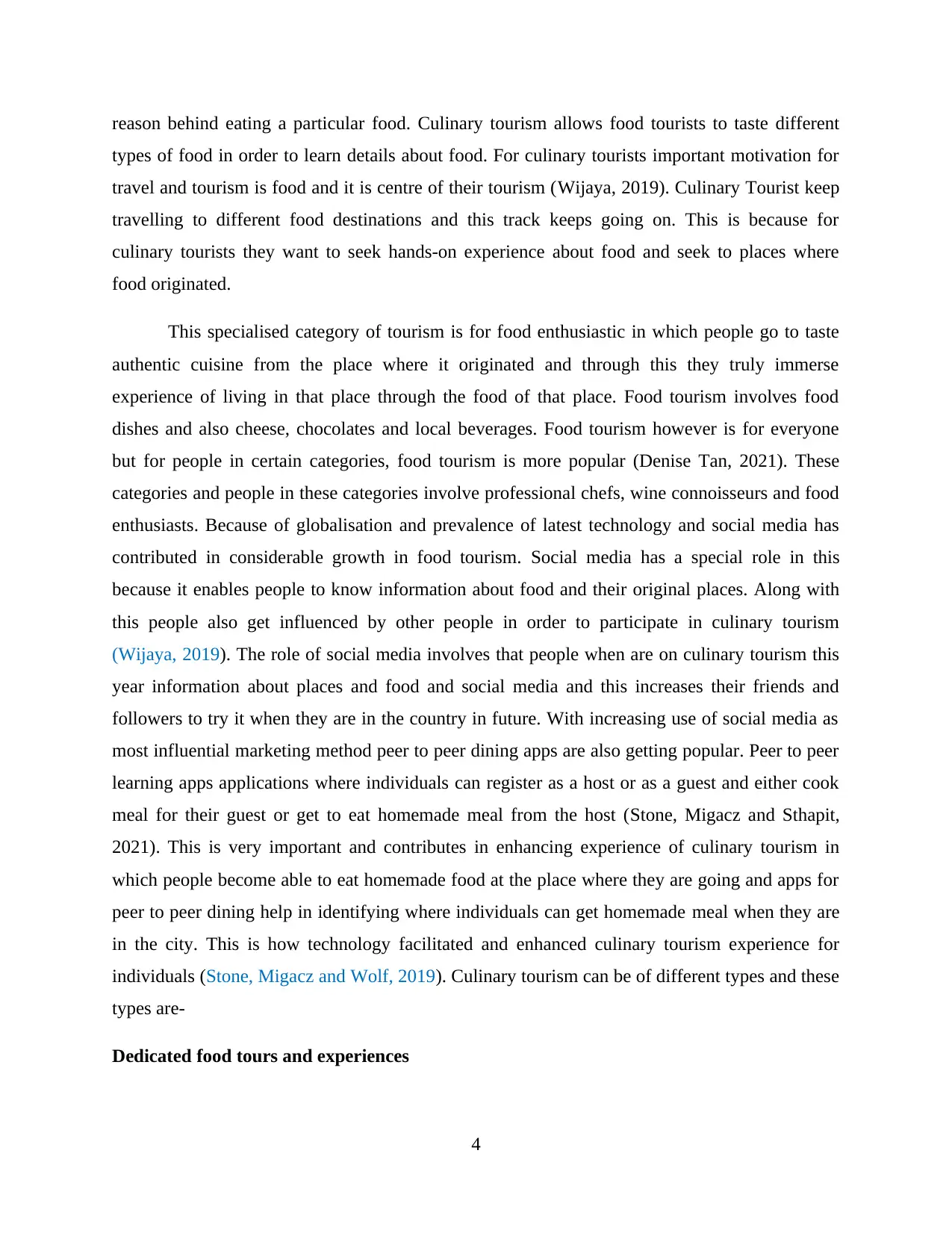
reason behind eating a particular food. Culinary tourism allows food tourists to taste different
types of food in order to learn details about food. For culinary tourists important motivation for
travel and tourism is food and it is centre of their tourism (Wijaya, 2019). Culinary Tourist keep
travelling to different food destinations and this track keeps going on. This is because for
culinary tourists they want to seek hands-on experience about food and seek to places where
food originated.
This specialised category of tourism is for food enthusiastic in which people go to taste
authentic cuisine from the place where it originated and through this they truly immerse
experience of living in that place through the food of that place. Food tourism involves food
dishes and also cheese, chocolates and local beverages. Food tourism however is for everyone
but for people in certain categories, food tourism is more popular (Denise Tan, 2021). These
categories and people in these categories involve professional chefs, wine connoisseurs and food
enthusiasts. Because of globalisation and prevalence of latest technology and social media has
contributed in considerable growth in food tourism. Social media has a special role in this
because it enables people to know information about food and their original places. Along with
this people also get influenced by other people in order to participate in culinary tourism
(Wijaya, 2019). The role of social media involves that people when are on culinary tourism this
year information about places and food and social media and this increases their friends and
followers to try it when they are in the country in future. With increasing use of social media as
most influential marketing method peer to peer dining apps are also getting popular. Peer to peer
learning apps applications where individuals can register as a host or as a guest and either cook
meal for their guest or get to eat homemade meal from the host (Stone, Migacz and Sthapit,
2021). This is very important and contributes in enhancing experience of culinary tourism in
which people become able to eat homemade food at the place where they are going and apps for
peer to peer dining help in identifying where individuals can get homemade meal when they are
in the city. This is how technology facilitated and enhanced culinary tourism experience for
individuals (Stone, Migacz and Wolf, 2019). Culinary tourism can be of different types and these
types are-
Dedicated food tours and experiences
4
types of food in order to learn details about food. For culinary tourists important motivation for
travel and tourism is food and it is centre of their tourism (Wijaya, 2019). Culinary Tourist keep
travelling to different food destinations and this track keeps going on. This is because for
culinary tourists they want to seek hands-on experience about food and seek to places where
food originated.
This specialised category of tourism is for food enthusiastic in which people go to taste
authentic cuisine from the place where it originated and through this they truly immerse
experience of living in that place through the food of that place. Food tourism involves food
dishes and also cheese, chocolates and local beverages. Food tourism however is for everyone
but for people in certain categories, food tourism is more popular (Denise Tan, 2021). These
categories and people in these categories involve professional chefs, wine connoisseurs and food
enthusiasts. Because of globalisation and prevalence of latest technology and social media has
contributed in considerable growth in food tourism. Social media has a special role in this
because it enables people to know information about food and their original places. Along with
this people also get influenced by other people in order to participate in culinary tourism
(Wijaya, 2019). The role of social media involves that people when are on culinary tourism this
year information about places and food and social media and this increases their friends and
followers to try it when they are in the country in future. With increasing use of social media as
most influential marketing method peer to peer dining apps are also getting popular. Peer to peer
learning apps applications where individuals can register as a host or as a guest and either cook
meal for their guest or get to eat homemade meal from the host (Stone, Migacz and Sthapit,
2021). This is very important and contributes in enhancing experience of culinary tourism in
which people become able to eat homemade food at the place where they are going and apps for
peer to peer dining help in identifying where individuals can get homemade meal when they are
in the city. This is how technology facilitated and enhanced culinary tourism experience for
individuals (Stone, Migacz and Wolf, 2019). Culinary tourism can be of different types and these
types are-
Dedicated food tours and experiences
4
Secure Best Marks with AI Grader
Need help grading? Try our AI Grader for instant feedback on your assignments.
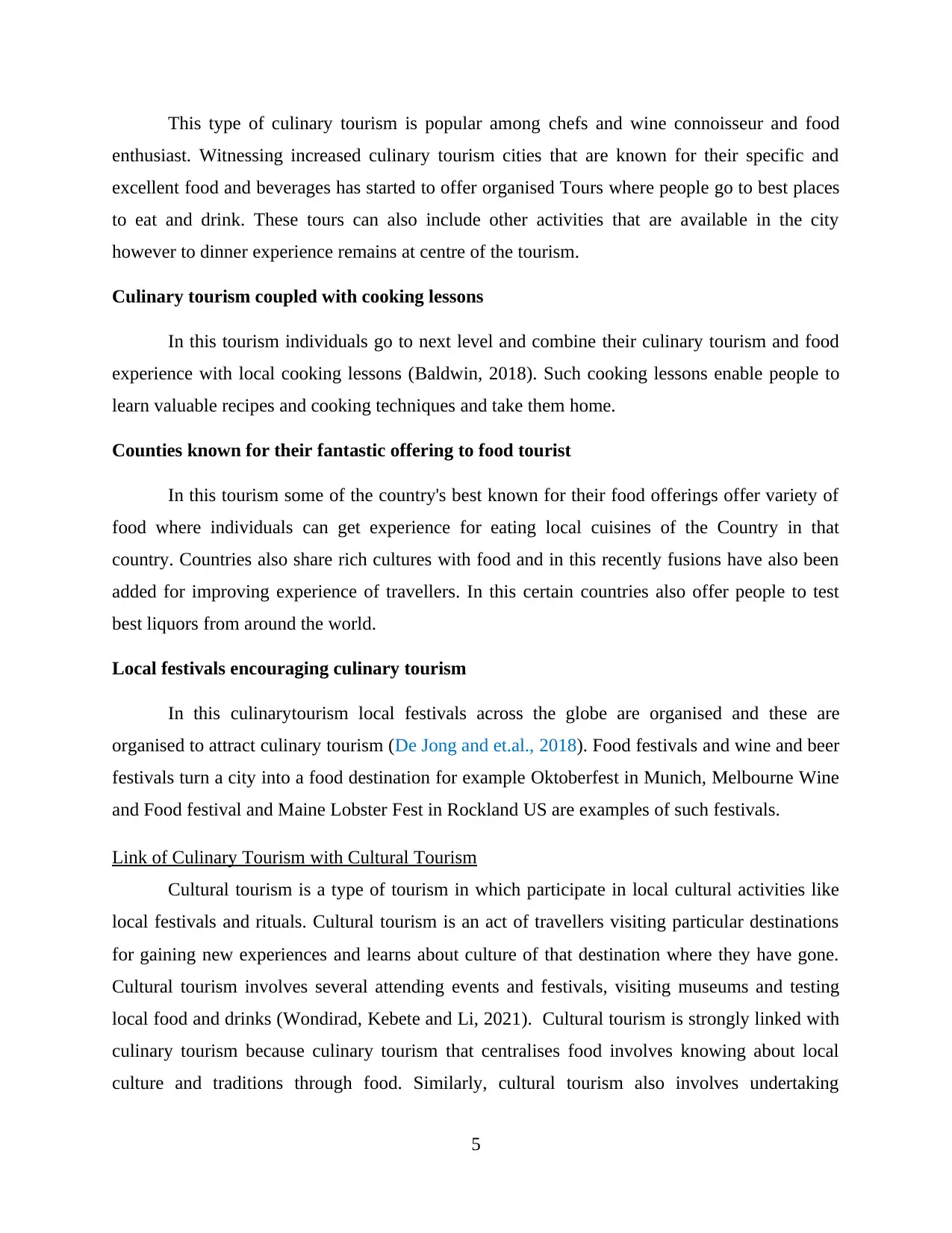
This type of culinary tourism is popular among chefs and wine connoisseur and food
enthusiast. Witnessing increased culinary tourism cities that are known for their specific and
excellent food and beverages has started to offer organised Tours where people go to best places
to eat and drink. These tours can also include other activities that are available in the city
however to dinner experience remains at centre of the tourism.
Culinary tourism coupled with cooking lessons
In this tourism individuals go to next level and combine their culinary tourism and food
experience with local cooking lessons (Baldwin, 2018). Such cooking lessons enable people to
learn valuable recipes and cooking techniques and take them home.
Counties known for their fantastic offering to food tourist
In this tourism some of the country's best known for their food offerings offer variety of
food where individuals can get experience for eating local cuisines of the Country in that
country. Countries also share rich cultures with food and in this recently fusions have also been
added for improving experience of travellers. In this certain countries also offer people to test
best liquors from around the world.
Local festivals encouraging culinary tourism
In this culinarytourism local festivals across the globe are organised and these are
organised to attract culinary tourism (De Jong and et.al., 2018). Food festivals and wine and beer
festivals turn a city into a food destination for example Oktoberfest in Munich, Melbourne Wine
and Food festival and Maine Lobster Fest in Rockland US are examples of such festivals.
Link of Culinary Tourism with Cultural Tourism
Cultural tourism is a type of tourism in which participate in local cultural activities like
local festivals and rituals. Cultural tourism is an act of travellers visiting particular destinations
for gaining new experiences and learns about culture of that destination where they have gone.
Cultural tourism involves several attending events and festivals, visiting museums and testing
local food and drinks (Wondirad, Kebete and Li, 2021). Cultural tourism is strongly linked with
culinary tourism because culinary tourism that centralises food involves knowing about local
culture and traditions through food. Similarly, cultural tourism also involves undertaking
5
enthusiast. Witnessing increased culinary tourism cities that are known for their specific and
excellent food and beverages has started to offer organised Tours where people go to best places
to eat and drink. These tours can also include other activities that are available in the city
however to dinner experience remains at centre of the tourism.
Culinary tourism coupled with cooking lessons
In this tourism individuals go to next level and combine their culinary tourism and food
experience with local cooking lessons (Baldwin, 2018). Such cooking lessons enable people to
learn valuable recipes and cooking techniques and take them home.
Counties known for their fantastic offering to food tourist
In this tourism some of the country's best known for their food offerings offer variety of
food where individuals can get experience for eating local cuisines of the Country in that
country. Countries also share rich cultures with food and in this recently fusions have also been
added for improving experience of travellers. In this certain countries also offer people to test
best liquors from around the world.
Local festivals encouraging culinary tourism
In this culinarytourism local festivals across the globe are organised and these are
organised to attract culinary tourism (De Jong and et.al., 2018). Food festivals and wine and beer
festivals turn a city into a food destination for example Oktoberfest in Munich, Melbourne Wine
and Food festival and Maine Lobster Fest in Rockland US are examples of such festivals.
Link of Culinary Tourism with Cultural Tourism
Cultural tourism is a type of tourism in which participate in local cultural activities like
local festivals and rituals. Cultural tourism is an act of travellers visiting particular destinations
for gaining new experiences and learns about culture of that destination where they have gone.
Cultural tourism involves several attending events and festivals, visiting museums and testing
local food and drinks (Wondirad, Kebete and Li, 2021). Cultural tourism is strongly linked with
culinary tourism because culinary tourism that centralises food involves knowing about local
culture and traditions through food. Similarly, cultural tourism also involves undertaking
5
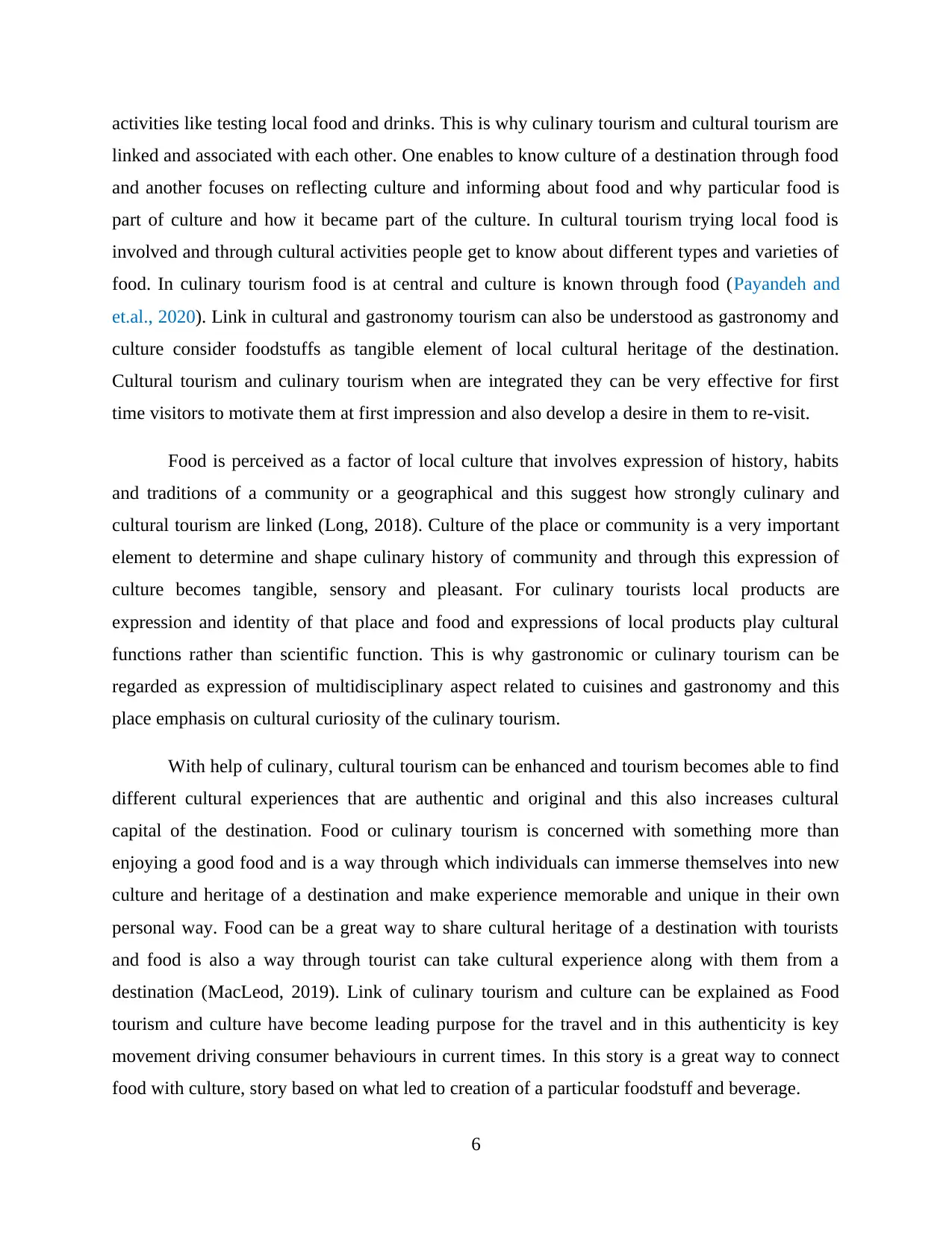
activities like testing local food and drinks. This is why culinary tourism and cultural tourism are
linked and associated with each other. One enables to know culture of a destination through food
and another focuses on reflecting culture and informing about food and why particular food is
part of culture and how it became part of the culture. In cultural tourism trying local food is
involved and through cultural activities people get to know about different types and varieties of
food. In culinary tourism food is at central and culture is known through food (Payandeh and
et.al., 2020). Link in cultural and gastronomy tourism can also be understood as gastronomy and
culture consider foodstuffs as tangible element of local cultural heritage of the destination.
Cultural tourism and culinary tourism when are integrated they can be very effective for first
time visitors to motivate them at first impression and also develop a desire in them to re-visit.
Food is perceived as a factor of local culture that involves expression of history, habits
and traditions of a community or a geographical and this suggest how strongly culinary and
cultural tourism are linked (Long, 2018). Culture of the place or community is a very important
element to determine and shape culinary history of community and through this expression of
culture becomes tangible, sensory and pleasant. For culinary tourists local products are
expression and identity of that place and food and expressions of local products play cultural
functions rather than scientific function. This is why gastronomic or culinary tourism can be
regarded as expression of multidisciplinary aspect related to cuisines and gastronomy and this
place emphasis on cultural curiosity of the culinary tourism.
With help of culinary, cultural tourism can be enhanced and tourism becomes able to find
different cultural experiences that are authentic and original and this also increases cultural
capital of the destination. Food or culinary tourism is concerned with something more than
enjoying a good food and is a way through which individuals can immerse themselves into new
culture and heritage of a destination and make experience memorable and unique in their own
personal way. Food can be a great way to share cultural heritage of a destination with tourists
and food is also a way through tourist can take cultural experience along with them from a
destination (MacLeod, 2019). Link of culinary tourism and culture can be explained as Food
tourism and culture have become leading purpose for the travel and in this authenticity is key
movement driving consumer behaviours in current times. In this story is a great way to connect
food with culture, story based on what led to creation of a particular foodstuff and beverage.
6
linked and associated with each other. One enables to know culture of a destination through food
and another focuses on reflecting culture and informing about food and why particular food is
part of culture and how it became part of the culture. In cultural tourism trying local food is
involved and through cultural activities people get to know about different types and varieties of
food. In culinary tourism food is at central and culture is known through food (Payandeh and
et.al., 2020). Link in cultural and gastronomy tourism can also be understood as gastronomy and
culture consider foodstuffs as tangible element of local cultural heritage of the destination.
Cultural tourism and culinary tourism when are integrated they can be very effective for first
time visitors to motivate them at first impression and also develop a desire in them to re-visit.
Food is perceived as a factor of local culture that involves expression of history, habits
and traditions of a community or a geographical and this suggest how strongly culinary and
cultural tourism are linked (Long, 2018). Culture of the place or community is a very important
element to determine and shape culinary history of community and through this expression of
culture becomes tangible, sensory and pleasant. For culinary tourists local products are
expression and identity of that place and food and expressions of local products play cultural
functions rather than scientific function. This is why gastronomic or culinary tourism can be
regarded as expression of multidisciplinary aspect related to cuisines and gastronomy and this
place emphasis on cultural curiosity of the culinary tourism.
With help of culinary, cultural tourism can be enhanced and tourism becomes able to find
different cultural experiences that are authentic and original and this also increases cultural
capital of the destination. Food or culinary tourism is concerned with something more than
enjoying a good food and is a way through which individuals can immerse themselves into new
culture and heritage of a destination and make experience memorable and unique in their own
personal way. Food can be a great way to share cultural heritage of a destination with tourists
and food is also a way through tourist can take cultural experience along with them from a
destination (MacLeod, 2019). Link of culinary tourism and culture can be explained as Food
tourism and culture have become leading purpose for the travel and in this authenticity is key
movement driving consumer behaviours in current times. In this story is a great way to connect
food with culture, story based on what led to creation of a particular foodstuff and beverage.
6
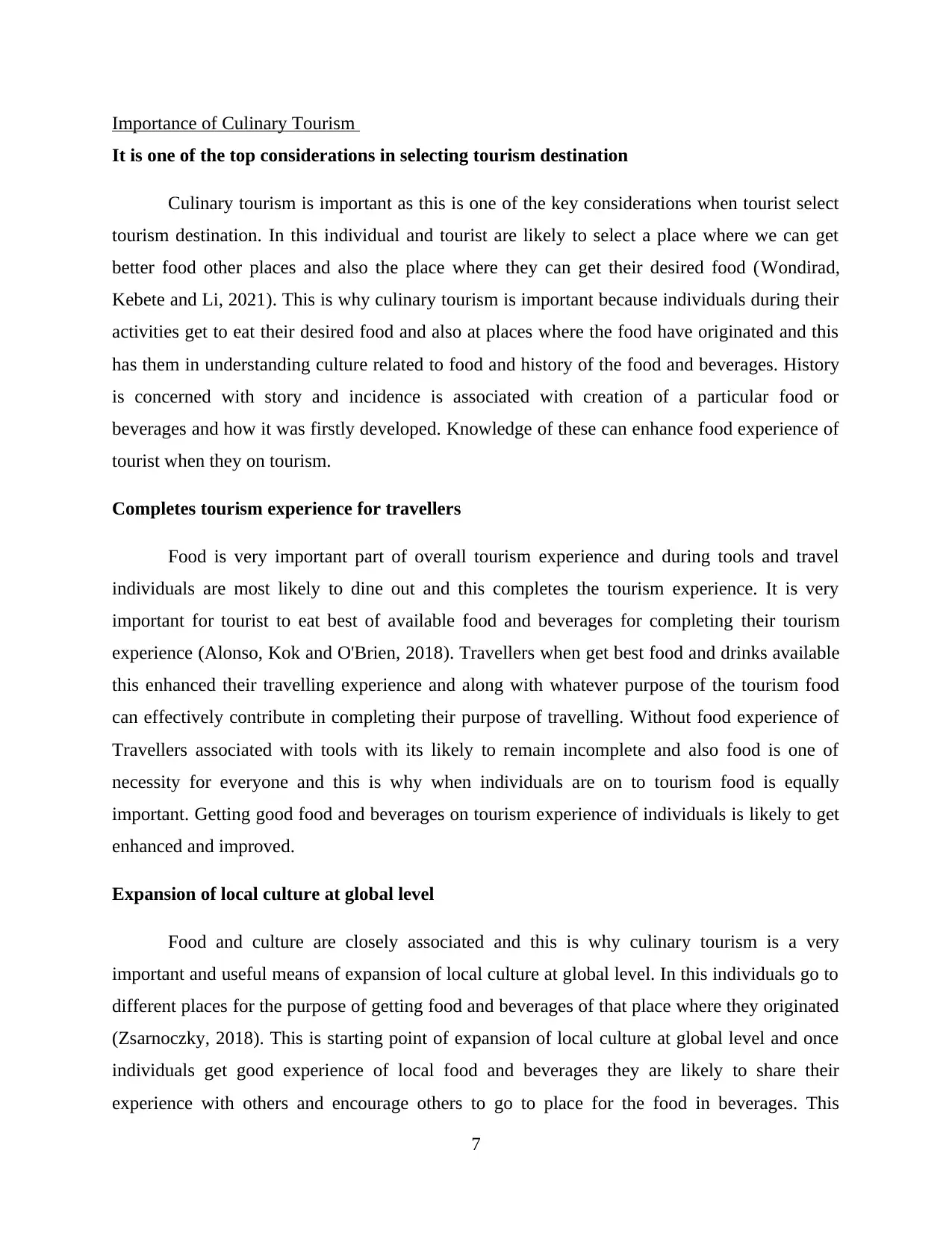
Importance of Culinary Tourism
It is one of the top considerations in selecting tourism destination
Culinary tourism is important as this is one of the key considerations when tourist select
tourism destination. In this individual and tourist are likely to select a place where we can get
better food other places and also the place where they can get their desired food (Wondirad,
Kebete and Li, 2021). This is why culinary tourism is important because individuals during their
activities get to eat their desired food and also at places where the food have originated and this
has them in understanding culture related to food and history of the food and beverages. History
is concerned with story and incidence is associated with creation of a particular food or
beverages and how it was firstly developed. Knowledge of these can enhance food experience of
tourist when they on tourism.
Completes tourism experience for travellers
Food is very important part of overall tourism experience and during tools and travel
individuals are most likely to dine out and this completes the tourism experience. It is very
important for tourist to eat best of available food and beverages for completing their tourism
experience (Alonso, Kok and O'Brien, 2018). Travellers when get best food and drinks available
this enhanced their travelling experience and along with whatever purpose of the tourism food
can effectively contribute in completing their purpose of travelling. Without food experience of
Travellers associated with tools with its likely to remain incomplete and also food is one of
necessity for everyone and this is why when individuals are on to tourism food is equally
important. Getting good food and beverages on tourism experience of individuals is likely to get
enhanced and improved.
Expansion of local culture at global level
Food and culture are closely associated and this is why culinary tourism is a very
important and useful means of expansion of local culture at global level. In this individuals go to
different places for the purpose of getting food and beverages of that place where they originated
(Zsarnoczky, 2018). This is starting point of expansion of local culture at global level and once
individuals get good experience of local food and beverages they are likely to share their
experience with others and encourage others to go to place for the food in beverages. This
7
It is one of the top considerations in selecting tourism destination
Culinary tourism is important as this is one of the key considerations when tourist select
tourism destination. In this individual and tourist are likely to select a place where we can get
better food other places and also the place where they can get their desired food (Wondirad,
Kebete and Li, 2021). This is why culinary tourism is important because individuals during their
activities get to eat their desired food and also at places where the food have originated and this
has them in understanding culture related to food and history of the food and beverages. History
is concerned with story and incidence is associated with creation of a particular food or
beverages and how it was firstly developed. Knowledge of these can enhance food experience of
tourist when they on tourism.
Completes tourism experience for travellers
Food is very important part of overall tourism experience and during tools and travel
individuals are most likely to dine out and this completes the tourism experience. It is very
important for tourist to eat best of available food and beverages for completing their tourism
experience (Alonso, Kok and O'Brien, 2018). Travellers when get best food and drinks available
this enhanced their travelling experience and along with whatever purpose of the tourism food
can effectively contribute in completing their purpose of travelling. Without food experience of
Travellers associated with tools with its likely to remain incomplete and also food is one of
necessity for everyone and this is why when individuals are on to tourism food is equally
important. Getting good food and beverages on tourism experience of individuals is likely to get
enhanced and improved.
Expansion of local culture at global level
Food and culture are closely associated and this is why culinary tourism is a very
important and useful means of expansion of local culture at global level. In this individuals go to
different places for the purpose of getting food and beverages of that place where they originated
(Zsarnoczky, 2018). This is starting point of expansion of local culture at global level and once
individuals get good experience of local food and beverages they are likely to share their
experience with others and encourage others to go to place for the food in beverages. This
7
Paraphrase This Document
Need a fresh take? Get an instant paraphrase of this document with our AI Paraphraser
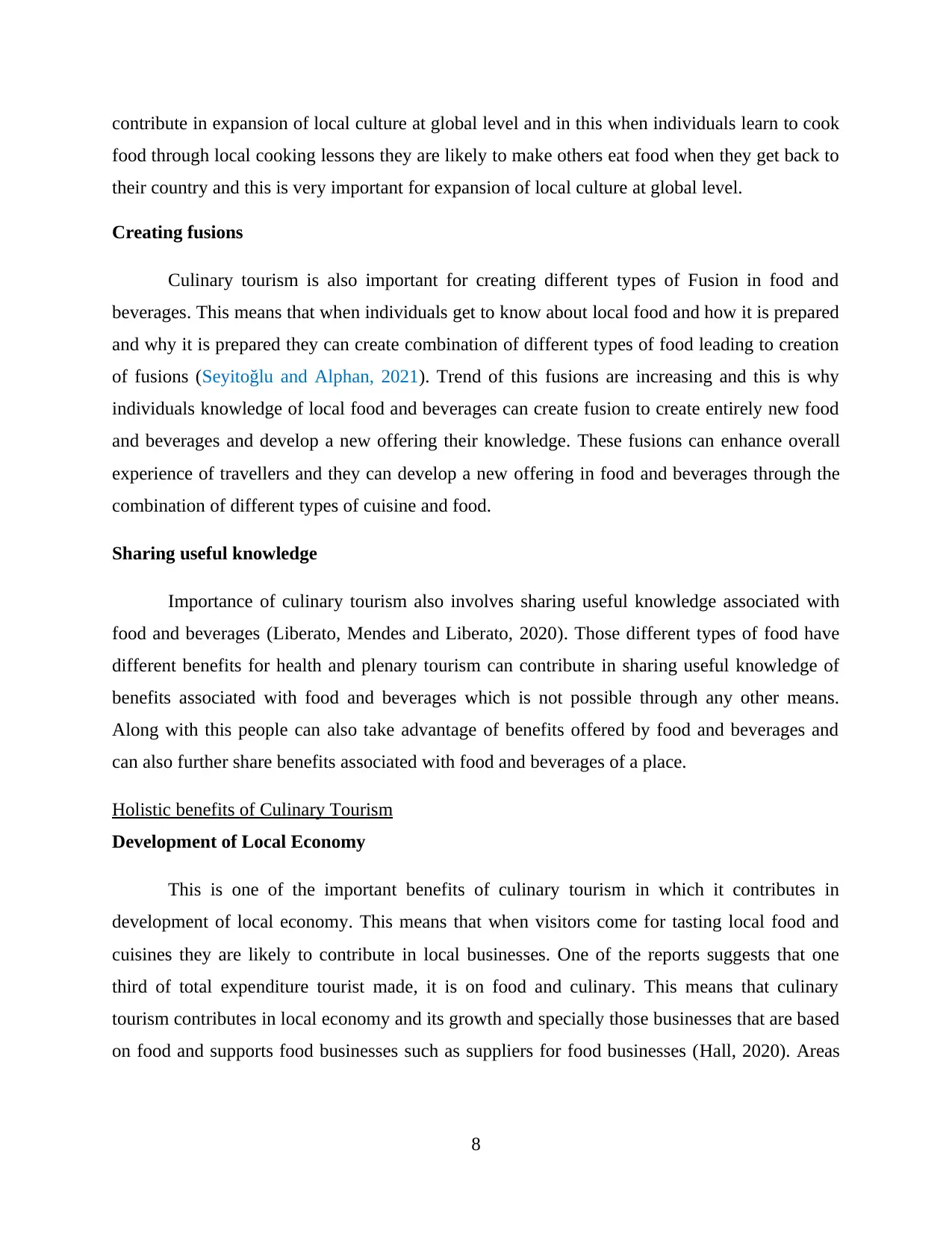
contribute in expansion of local culture at global level and in this when individuals learn to cook
food through local cooking lessons they are likely to make others eat food when they get back to
their country and this is very important for expansion of local culture at global level.
Creating fusions
Culinary tourism is also important for creating different types of Fusion in food and
beverages. This means that when individuals get to know about local food and how it is prepared
and why it is prepared they can create combination of different types of food leading to creation
of fusions (Seyitoğlu and Alphan, 2021). Trend of this fusions are increasing and this is why
individuals knowledge of local food and beverages can create fusion to create entirely new food
and beverages and develop a new offering their knowledge. These fusions can enhance overall
experience of travellers and they can develop a new offering in food and beverages through the
combination of different types of cuisine and food.
Sharing useful knowledge
Importance of culinary tourism also involves sharing useful knowledge associated with
food and beverages (Liberato, Mendes and Liberato, 2020). Those different types of food have
different benefits for health and plenary tourism can contribute in sharing useful knowledge of
benefits associated with food and beverages which is not possible through any other means.
Along with this people can also take advantage of benefits offered by food and beverages and
can also further share benefits associated with food and beverages of a place.
Holistic benefits of Culinary Tourism
Development of Local Economy
This is one of the important benefits of culinary tourism in which it contributes in
development of local economy. This means that when visitors come for tasting local food and
cuisines they are likely to contribute in local businesses. One of the reports suggests that one
third of total expenditure tourist made, it is on food and culinary. This means that culinary
tourism contributes in local economy and its growth and specially those businesses that are based
on food and supports food businesses such as suppliers for food businesses (Hall, 2020). Areas
8
food through local cooking lessons they are likely to make others eat food when they get back to
their country and this is very important for expansion of local culture at global level.
Creating fusions
Culinary tourism is also important for creating different types of Fusion in food and
beverages. This means that when individuals get to know about local food and how it is prepared
and why it is prepared they can create combination of different types of food leading to creation
of fusions (Seyitoğlu and Alphan, 2021). Trend of this fusions are increasing and this is why
individuals knowledge of local food and beverages can create fusion to create entirely new food
and beverages and develop a new offering their knowledge. These fusions can enhance overall
experience of travellers and they can develop a new offering in food and beverages through the
combination of different types of cuisine and food.
Sharing useful knowledge
Importance of culinary tourism also involves sharing useful knowledge associated with
food and beverages (Liberato, Mendes and Liberato, 2020). Those different types of food have
different benefits for health and plenary tourism can contribute in sharing useful knowledge of
benefits associated with food and beverages which is not possible through any other means.
Along with this people can also take advantage of benefits offered by food and beverages and
can also further share benefits associated with food and beverages of a place.
Holistic benefits of Culinary Tourism
Development of Local Economy
This is one of the important benefits of culinary tourism in which it contributes in
development of local economy. This means that when visitors come for tasting local food and
cuisines they are likely to contribute in local businesses. One of the reports suggests that one
third of total expenditure tourist made, it is on food and culinary. This means that culinary
tourism contributes in local economy and its growth and specially those businesses that are based
on food and supports food businesses such as suppliers for food businesses (Hall, 2020). Areas
8
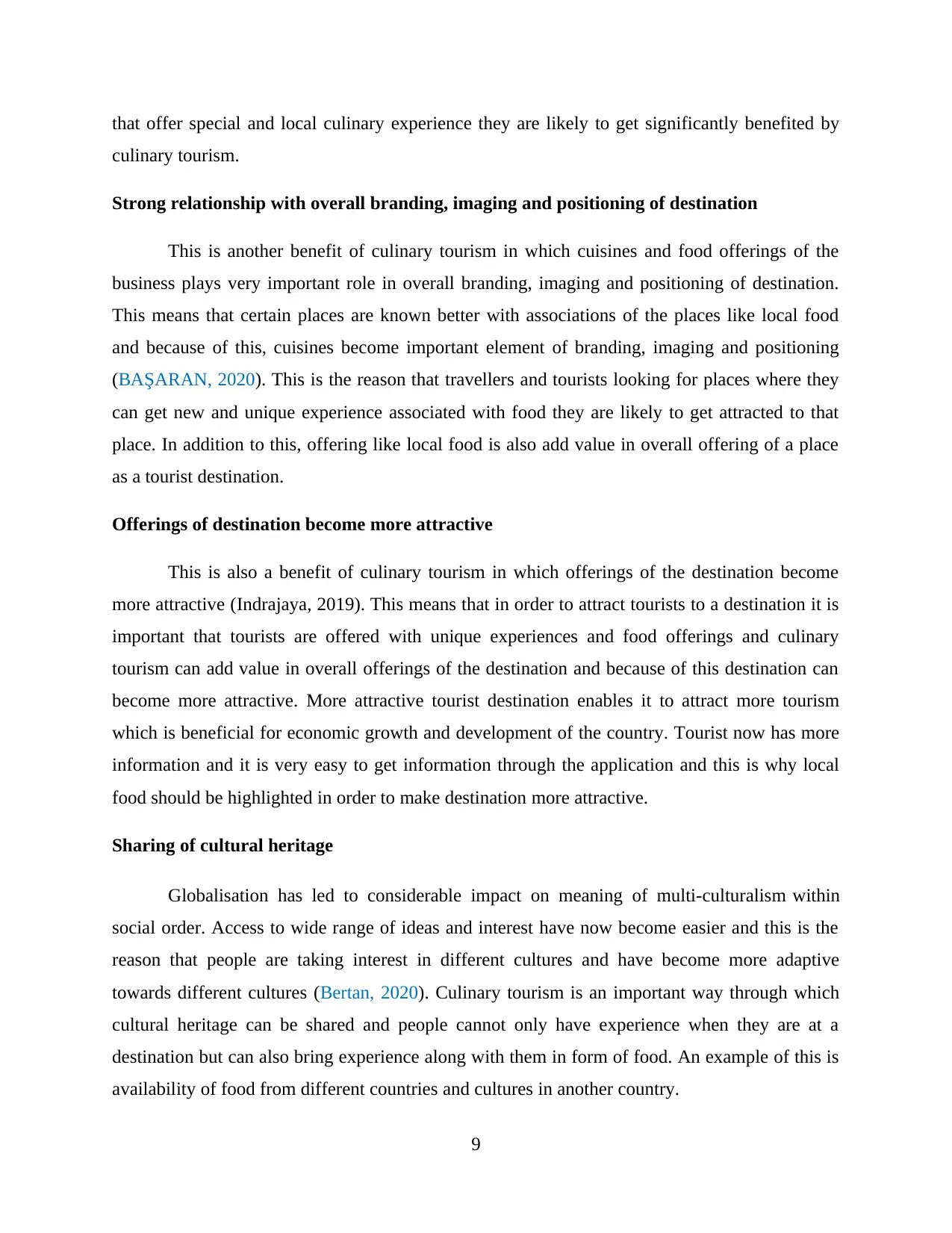
that offer special and local culinary experience they are likely to get significantly benefited by
culinary tourism.
Strong relationship with overall branding, imaging and positioning of destination
This is another benefit of culinary tourism in which cuisines and food offerings of the
business plays very important role in overall branding, imaging and positioning of destination.
This means that certain places are known better with associations of the places like local food
and because of this, cuisines become important element of branding, imaging and positioning
(BAŞARAN, 2020). This is the reason that travellers and tourists looking for places where they
can get new and unique experience associated with food they are likely to get attracted to that
place. In addition to this, offering like local food is also add value in overall offering of a place
as a tourist destination.
Offerings of destination become more attractive
This is also a benefit of culinary tourism in which offerings of the destination become
more attractive (Indrajaya, 2019). This means that in order to attract tourists to a destination it is
important that tourists are offered with unique experiences and food offerings and culinary
tourism can add value in overall offerings of the destination and because of this destination can
become more attractive. More attractive tourist destination enables it to attract more tourism
which is beneficial for economic growth and development of the country. Tourist now has more
information and it is very easy to get information through the application and this is why local
food should be highlighted in order to make destination more attractive.
Sharing of cultural heritage
Globalisation has led to considerable impact on meaning of multi-culturalism within
social order. Access to wide range of ideas and interest have now become easier and this is the
reason that people are taking interest in different cultures and have become more adaptive
towards different cultures (Bertan, 2020). Culinary tourism is an important way through which
cultural heritage can be shared and people cannot only have experience when they are at a
destination but can also bring experience along with them in form of food. An example of this is
availability of food from different countries and cultures in another country.
9
culinary tourism.
Strong relationship with overall branding, imaging and positioning of destination
This is another benefit of culinary tourism in which cuisines and food offerings of the
business plays very important role in overall branding, imaging and positioning of destination.
This means that certain places are known better with associations of the places like local food
and because of this, cuisines become important element of branding, imaging and positioning
(BAŞARAN, 2020). This is the reason that travellers and tourists looking for places where they
can get new and unique experience associated with food they are likely to get attracted to that
place. In addition to this, offering like local food is also add value in overall offering of a place
as a tourist destination.
Offerings of destination become more attractive
This is also a benefit of culinary tourism in which offerings of the destination become
more attractive (Indrajaya, 2019). This means that in order to attract tourists to a destination it is
important that tourists are offered with unique experiences and food offerings and culinary
tourism can add value in overall offerings of the destination and because of this destination can
become more attractive. More attractive tourist destination enables it to attract more tourism
which is beneficial for economic growth and development of the country. Tourist now has more
information and it is very easy to get information through the application and this is why local
food should be highlighted in order to make destination more attractive.
Sharing of cultural heritage
Globalisation has led to considerable impact on meaning of multi-culturalism within
social order. Access to wide range of ideas and interest have now become easier and this is the
reason that people are taking interest in different cultures and have become more adaptive
towards different cultures (Bertan, 2020). Culinary tourism is an important way through which
cultural heritage can be shared and people cannot only have experience when they are at a
destination but can also bring experience along with them in form of food. An example of this is
availability of food from different countries and cultures in another country.
9
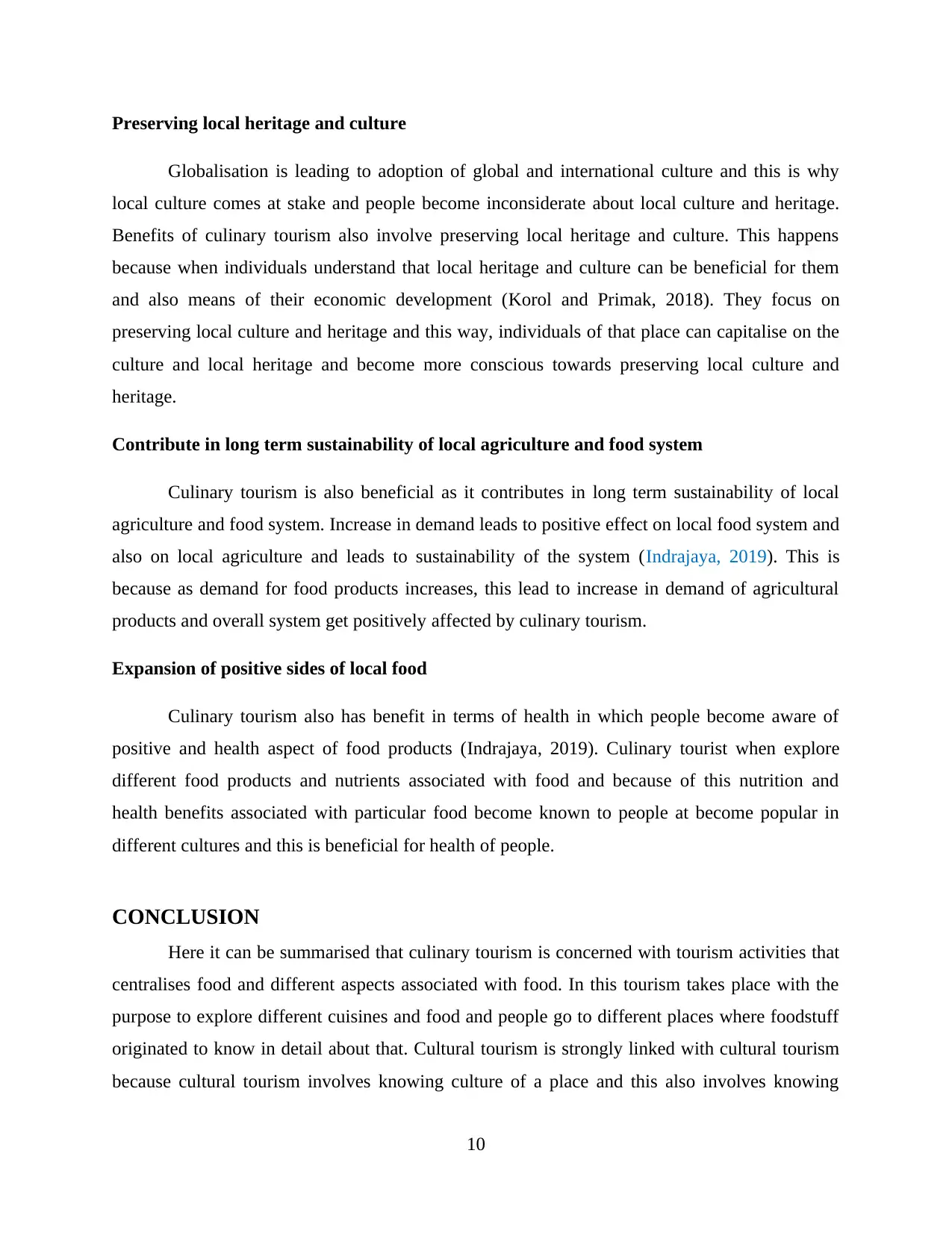
Preserving local heritage and culture
Globalisation is leading to adoption of global and international culture and this is why
local culture comes at stake and people become inconsiderate about local culture and heritage.
Benefits of culinary tourism also involve preserving local heritage and culture. This happens
because when individuals understand that local heritage and culture can be beneficial for them
and also means of their economic development (Korol and Primak, 2018). They focus on
preserving local culture and heritage and this way, individuals of that place can capitalise on the
culture and local heritage and become more conscious towards preserving local culture and
heritage.
Contribute in long term sustainability of local agriculture and food system
Culinary tourism is also beneficial as it contributes in long term sustainability of local
agriculture and food system. Increase in demand leads to positive effect on local food system and
also on local agriculture and leads to sustainability of the system (Indrajaya, 2019). This is
because as demand for food products increases, this lead to increase in demand of agricultural
products and overall system get positively affected by culinary tourism.
Expansion of positive sides of local food
Culinary tourism also has benefit in terms of health in which people become aware of
positive and health aspect of food products (Indrajaya, 2019). Culinary tourist when explore
different food products and nutrients associated with food and because of this nutrition and
health benefits associated with particular food become known to people at become popular in
different cultures and this is beneficial for health of people.
CONCLUSION
Here it can be summarised that culinary tourism is concerned with tourism activities that
centralises food and different aspects associated with food. In this tourism takes place with the
purpose to explore different cuisines and food and people go to different places where foodstuff
originated to know in detail about that. Cultural tourism is strongly linked with cultural tourism
because cultural tourism involves knowing culture of a place and this also involves knowing
10
Globalisation is leading to adoption of global and international culture and this is why
local culture comes at stake and people become inconsiderate about local culture and heritage.
Benefits of culinary tourism also involve preserving local heritage and culture. This happens
because when individuals understand that local heritage and culture can be beneficial for them
and also means of their economic development (Korol and Primak, 2018). They focus on
preserving local culture and heritage and this way, individuals of that place can capitalise on the
culture and local heritage and become more conscious towards preserving local culture and
heritage.
Contribute in long term sustainability of local agriculture and food system
Culinary tourism is also beneficial as it contributes in long term sustainability of local
agriculture and food system. Increase in demand leads to positive effect on local food system and
also on local agriculture and leads to sustainability of the system (Indrajaya, 2019). This is
because as demand for food products increases, this lead to increase in demand of agricultural
products and overall system get positively affected by culinary tourism.
Expansion of positive sides of local food
Culinary tourism also has benefit in terms of health in which people become aware of
positive and health aspect of food products (Indrajaya, 2019). Culinary tourist when explore
different food products and nutrients associated with food and because of this nutrition and
health benefits associated with particular food become known to people at become popular in
different cultures and this is beneficial for health of people.
CONCLUSION
Here it can be summarised that culinary tourism is concerned with tourism activities that
centralises food and different aspects associated with food. In this tourism takes place with the
purpose to explore different cuisines and food and people go to different places where foodstuff
originated to know in detail about that. Cultural tourism is strongly linked with cultural tourism
because cultural tourism involves knowing culture of a place and this also involves knowing
10
Secure Best Marks with AI Grader
Need help grading? Try our AI Grader for instant feedback on your assignments.
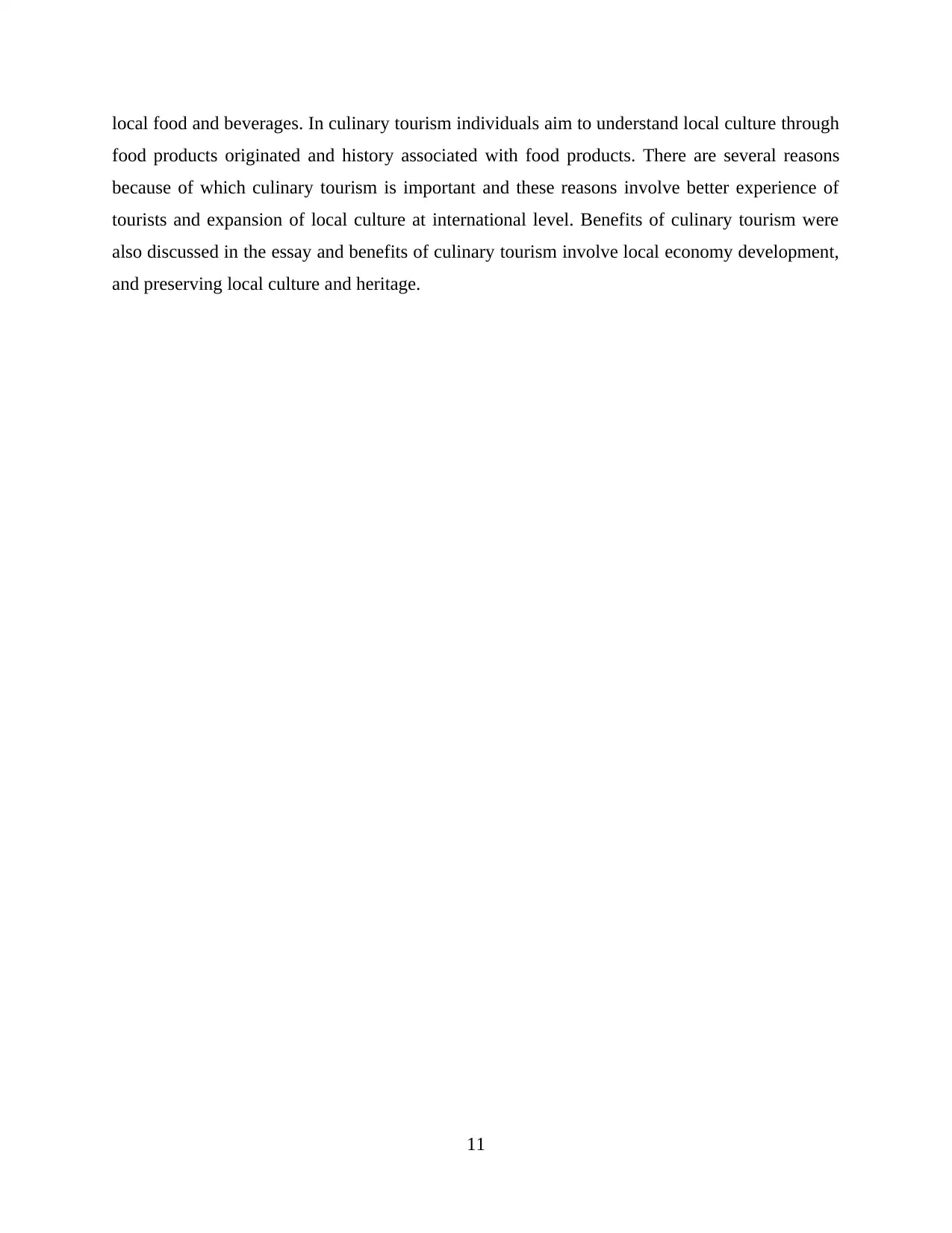
local food and beverages. In culinary tourism individuals aim to understand local culture through
food products originated and history associated with food products. There are several reasons
because of which culinary tourism is important and these reasons involve better experience of
tourists and expansion of local culture at international level. Benefits of culinary tourism were
also discussed in the essay and benefits of culinary tourism involve local economy development,
and preserving local culture and heritage.
11
food products originated and history associated with food products. There are several reasons
because of which culinary tourism is important and these reasons involve better experience of
tourists and expansion of local culture at international level. Benefits of culinary tourism were
also discussed in the essay and benefits of culinary tourism involve local economy development,
and preserving local culture and heritage.
11
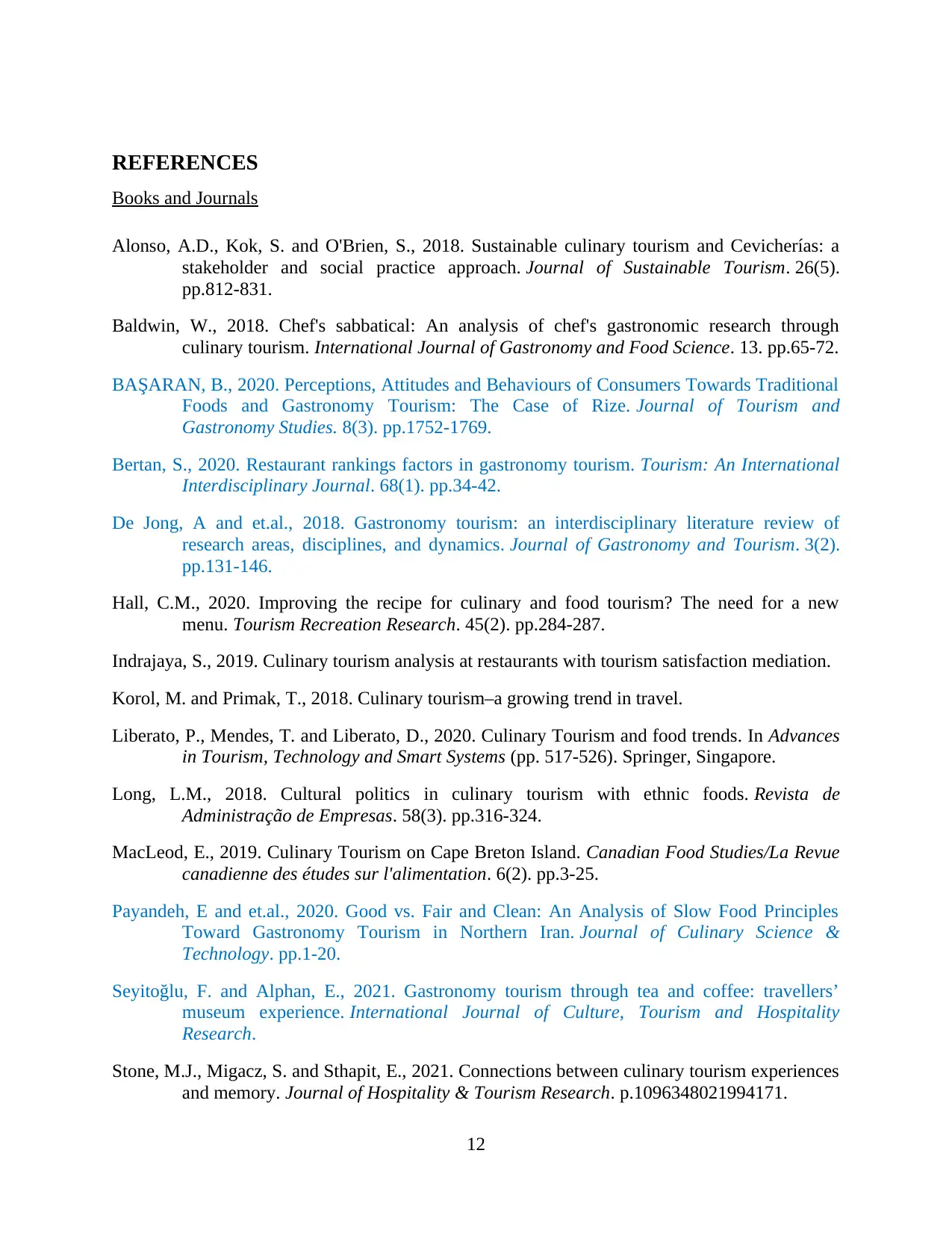
REFERENCES
Books and Journals
Alonso, A.D., Kok, S. and O'Brien, S., 2018. Sustainable culinary tourism and Cevicherías: a
stakeholder and social practice approach. Journal of Sustainable Tourism. 26(5).
pp.812-831.
Baldwin, W., 2018. Chef's sabbatical: An analysis of chef's gastronomic research through
culinary tourism. International Journal of Gastronomy and Food Science. 13. pp.65-72.
BAŞARAN, B., 2020. Perceptions, Attitudes and Behaviours of Consumers Towards Traditional
Foods and Gastronomy Tourism: The Case of Rize. Journal of Tourism and
Gastronomy Studies. 8(3). pp.1752-1769.
Bertan, S., 2020. Restaurant rankings factors in gastronomy tourism. Tourism: An International
Interdisciplinary Journal. 68(1). pp.34-42.
De Jong, A and et.al., 2018. Gastronomy tourism: an interdisciplinary literature review of
research areas, disciplines, and dynamics. Journal of Gastronomy and Tourism. 3(2).
pp.131-146.
Hall, C.M., 2020. Improving the recipe for culinary and food tourism? The need for a new
menu. Tourism Recreation Research. 45(2). pp.284-287.
Indrajaya, S., 2019. Culinary tourism analysis at restaurants with tourism satisfaction mediation.
Korol, M. and Primak, T., 2018. Culinary tourism–a growing trend in travel.
Liberato, P., Mendes, T. and Liberato, D., 2020. Culinary Tourism and food trends. In Advances
in Tourism, Technology and Smart Systems (pp. 517-526). Springer, Singapore.
Long, L.M., 2018. Cultural politics in culinary tourism with ethnic foods. Revista de
Administração de Empresas. 58(3). pp.316-324.
MacLeod, E., 2019. Culinary Tourism on Cape Breton Island. Canadian Food Studies/La Revue
canadienne des études sur l'alimentation. 6(2). pp.3-25.
Payandeh, E and et.al., 2020. Good vs. Fair and Clean: An Analysis of Slow Food Principles
Toward Gastronomy Tourism in Northern Iran. Journal of Culinary Science &
Technology. pp.1-20.
Seyitoğlu, F. and Alphan, E., 2021. Gastronomy tourism through tea and coffee: travellers’
museum experience. International Journal of Culture, Tourism and Hospitality
Research.
Stone, M.J., Migacz, S. and Sthapit, E., 2021. Connections between culinary tourism experiences
and memory. Journal of Hospitality & Tourism Research. p.1096348021994171.
12
Books and Journals
Alonso, A.D., Kok, S. and O'Brien, S., 2018. Sustainable culinary tourism and Cevicherías: a
stakeholder and social practice approach. Journal of Sustainable Tourism. 26(5).
pp.812-831.
Baldwin, W., 2018. Chef's sabbatical: An analysis of chef's gastronomic research through
culinary tourism. International Journal of Gastronomy and Food Science. 13. pp.65-72.
BAŞARAN, B., 2020. Perceptions, Attitudes and Behaviours of Consumers Towards Traditional
Foods and Gastronomy Tourism: The Case of Rize. Journal of Tourism and
Gastronomy Studies. 8(3). pp.1752-1769.
Bertan, S., 2020. Restaurant rankings factors in gastronomy tourism. Tourism: An International
Interdisciplinary Journal. 68(1). pp.34-42.
De Jong, A and et.al., 2018. Gastronomy tourism: an interdisciplinary literature review of
research areas, disciplines, and dynamics. Journal of Gastronomy and Tourism. 3(2).
pp.131-146.
Hall, C.M., 2020. Improving the recipe for culinary and food tourism? The need for a new
menu. Tourism Recreation Research. 45(2). pp.284-287.
Indrajaya, S., 2019. Culinary tourism analysis at restaurants with tourism satisfaction mediation.
Korol, M. and Primak, T., 2018. Culinary tourism–a growing trend in travel.
Liberato, P., Mendes, T. and Liberato, D., 2020. Culinary Tourism and food trends. In Advances
in Tourism, Technology and Smart Systems (pp. 517-526). Springer, Singapore.
Long, L.M., 2018. Cultural politics in culinary tourism with ethnic foods. Revista de
Administração de Empresas. 58(3). pp.316-324.
MacLeod, E., 2019. Culinary Tourism on Cape Breton Island. Canadian Food Studies/La Revue
canadienne des études sur l'alimentation. 6(2). pp.3-25.
Payandeh, E and et.al., 2020. Good vs. Fair and Clean: An Analysis of Slow Food Principles
Toward Gastronomy Tourism in Northern Iran. Journal of Culinary Science &
Technology. pp.1-20.
Seyitoğlu, F. and Alphan, E., 2021. Gastronomy tourism through tea and coffee: travellers’
museum experience. International Journal of Culture, Tourism and Hospitality
Research.
Stone, M.J., Migacz, S. and Sthapit, E., 2021. Connections between culinary tourism experiences
and memory. Journal of Hospitality & Tourism Research. p.1096348021994171.
12
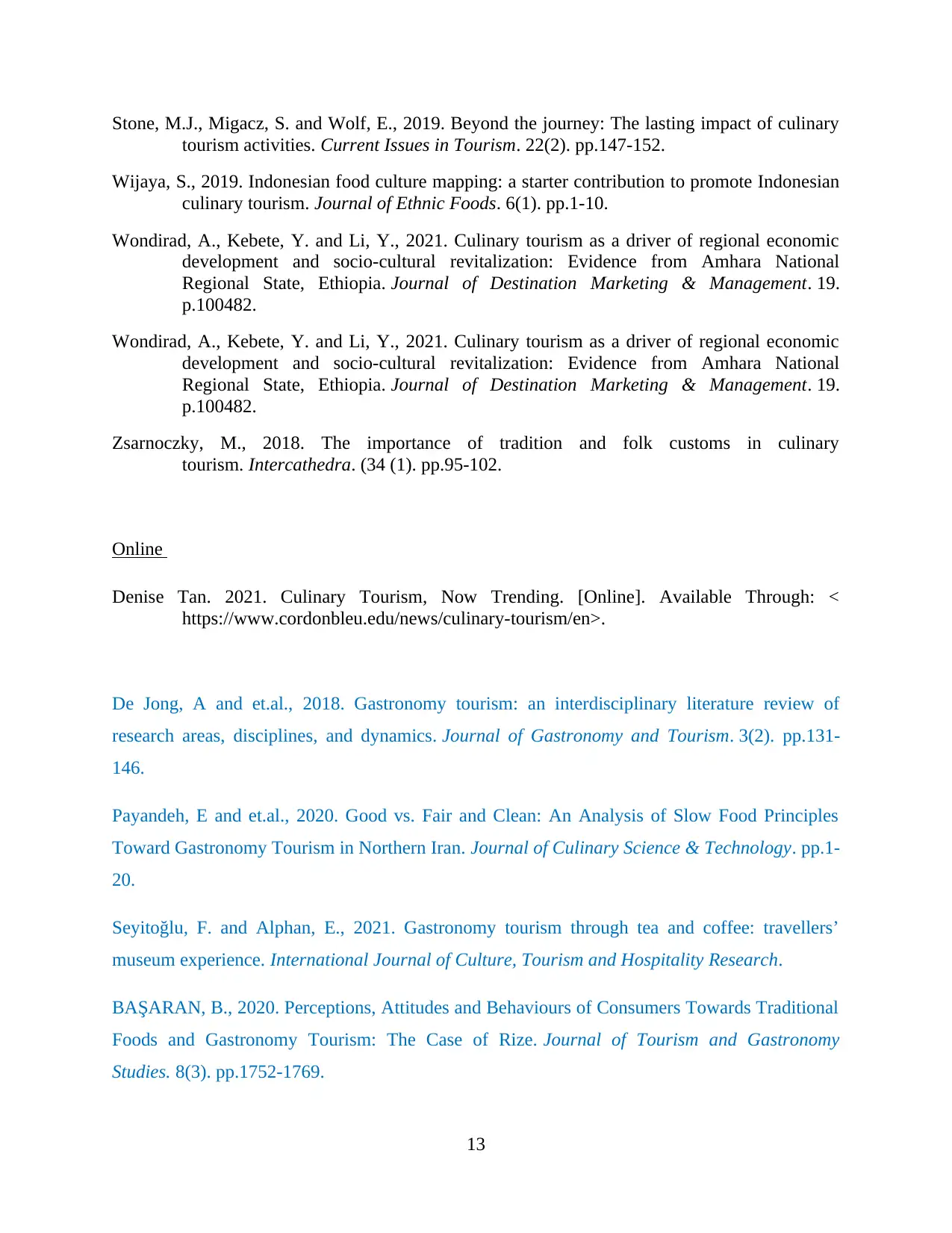
Stone, M.J., Migacz, S. and Wolf, E., 2019. Beyond the journey: The lasting impact of culinary
tourism activities. Current Issues in Tourism. 22(2). pp.147-152.
Wijaya, S., 2019. Indonesian food culture mapping: a starter contribution to promote Indonesian
culinary tourism. Journal of Ethnic Foods. 6(1). pp.1-10.
Wondirad, A., Kebete, Y. and Li, Y., 2021. Culinary tourism as a driver of regional economic
development and socio-cultural revitalization: Evidence from Amhara National
Regional State, Ethiopia. Journal of Destination Marketing & Management. 19.
p.100482.
Wondirad, A., Kebete, Y. and Li, Y., 2021. Culinary tourism as a driver of regional economic
development and socio-cultural revitalization: Evidence from Amhara National
Regional State, Ethiopia. Journal of Destination Marketing & Management. 19.
p.100482.
Zsarnoczky, M., 2018. The importance of tradition and folk customs in culinary
tourism. Intercathedra. (34 (1). pp.95-102.
Online
Denise Tan. 2021. Culinary Tourism, Now Trending. [Online]. Available Through: <
https://www.cordonbleu.edu/news/culinary-tourism/en>.
De Jong, A and et.al., 2018. Gastronomy tourism: an interdisciplinary literature review of
research areas, disciplines, and dynamics. Journal of Gastronomy and Tourism. 3(2). pp.131-
146.
Payandeh, E and et.al., 2020. Good vs. Fair and Clean: An Analysis of Slow Food Principles
Toward Gastronomy Tourism in Northern Iran. Journal of Culinary Science & Technology. pp.1-
20.
Seyitoğlu, F. and Alphan, E., 2021. Gastronomy tourism through tea and coffee: travellers’
museum experience. International Journal of Culture, Tourism and Hospitality Research.
BAŞARAN, B., 2020. Perceptions, Attitudes and Behaviours of Consumers Towards Traditional
Foods and Gastronomy Tourism: The Case of Rize. Journal of Tourism and Gastronomy
Studies. 8(3). pp.1752-1769.
13
tourism activities. Current Issues in Tourism. 22(2). pp.147-152.
Wijaya, S., 2019. Indonesian food culture mapping: a starter contribution to promote Indonesian
culinary tourism. Journal of Ethnic Foods. 6(1). pp.1-10.
Wondirad, A., Kebete, Y. and Li, Y., 2021. Culinary tourism as a driver of regional economic
development and socio-cultural revitalization: Evidence from Amhara National
Regional State, Ethiopia. Journal of Destination Marketing & Management. 19.
p.100482.
Wondirad, A., Kebete, Y. and Li, Y., 2021. Culinary tourism as a driver of regional economic
development and socio-cultural revitalization: Evidence from Amhara National
Regional State, Ethiopia. Journal of Destination Marketing & Management. 19.
p.100482.
Zsarnoczky, M., 2018. The importance of tradition and folk customs in culinary
tourism. Intercathedra. (34 (1). pp.95-102.
Online
Denise Tan. 2021. Culinary Tourism, Now Trending. [Online]. Available Through: <
https://www.cordonbleu.edu/news/culinary-tourism/en>.
De Jong, A and et.al., 2018. Gastronomy tourism: an interdisciplinary literature review of
research areas, disciplines, and dynamics. Journal of Gastronomy and Tourism. 3(2). pp.131-
146.
Payandeh, E and et.al., 2020. Good vs. Fair and Clean: An Analysis of Slow Food Principles
Toward Gastronomy Tourism in Northern Iran. Journal of Culinary Science & Technology. pp.1-
20.
Seyitoğlu, F. and Alphan, E., 2021. Gastronomy tourism through tea and coffee: travellers’
museum experience. International Journal of Culture, Tourism and Hospitality Research.
BAŞARAN, B., 2020. Perceptions, Attitudes and Behaviours of Consumers Towards Traditional
Foods and Gastronomy Tourism: The Case of Rize. Journal of Tourism and Gastronomy
Studies. 8(3). pp.1752-1769.
13
Paraphrase This Document
Need a fresh take? Get an instant paraphrase of this document with our AI Paraphraser
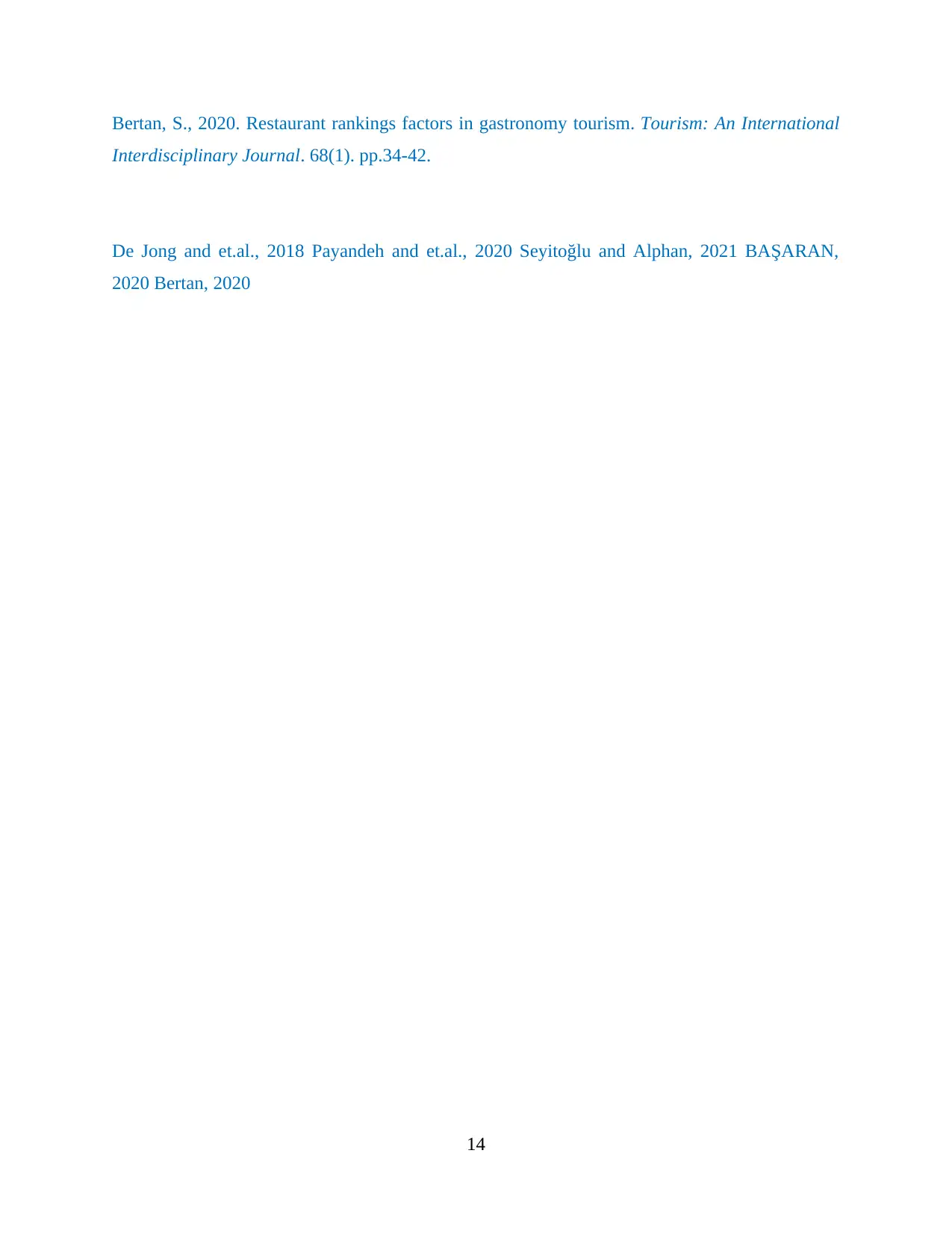
Bertan, S., 2020. Restaurant rankings factors in gastronomy tourism. Tourism: An International
Interdisciplinary Journal. 68(1). pp.34-42.
De Jong and et.al., 2018 Payandeh and et.al., 2020 Seyitoğlu and Alphan, 2021 BAŞARAN,
2020 Bertan, 2020
14
Interdisciplinary Journal. 68(1). pp.34-42.
De Jong and et.al., 2018 Payandeh and et.al., 2020 Seyitoğlu and Alphan, 2021 BAŞARAN,
2020 Bertan, 2020
14
1 out of 14
Related Documents
Your All-in-One AI-Powered Toolkit for Academic Success.
+13062052269
info@desklib.com
Available 24*7 on WhatsApp / Email
![[object Object]](/_next/static/media/star-bottom.7253800d.svg)
Unlock your academic potential
© 2024 | Zucol Services PVT LTD | All rights reserved.





